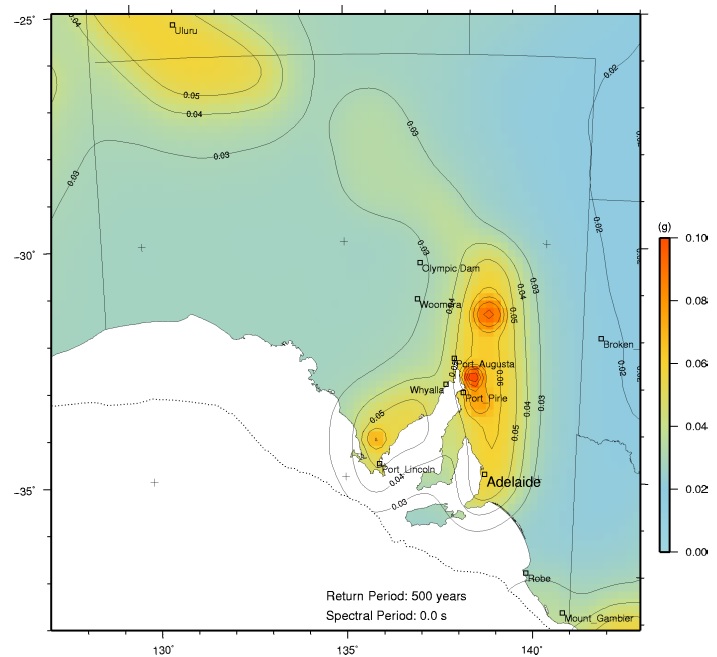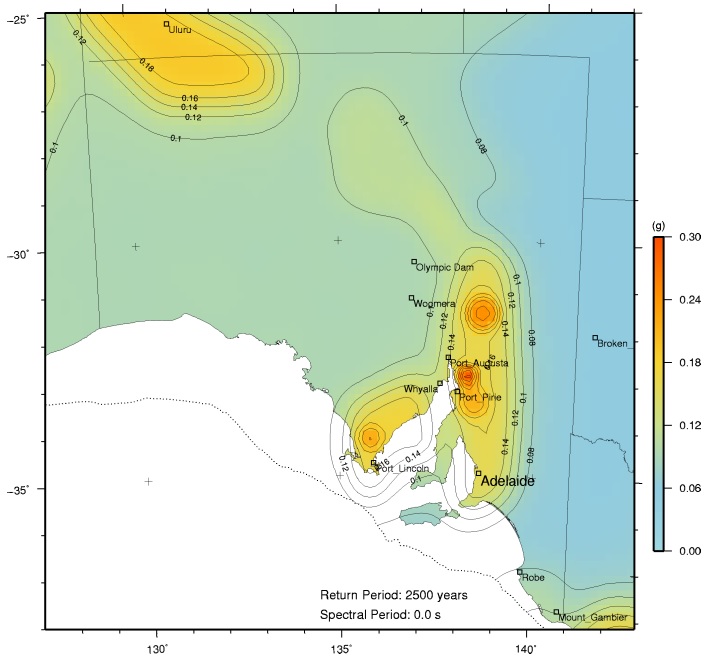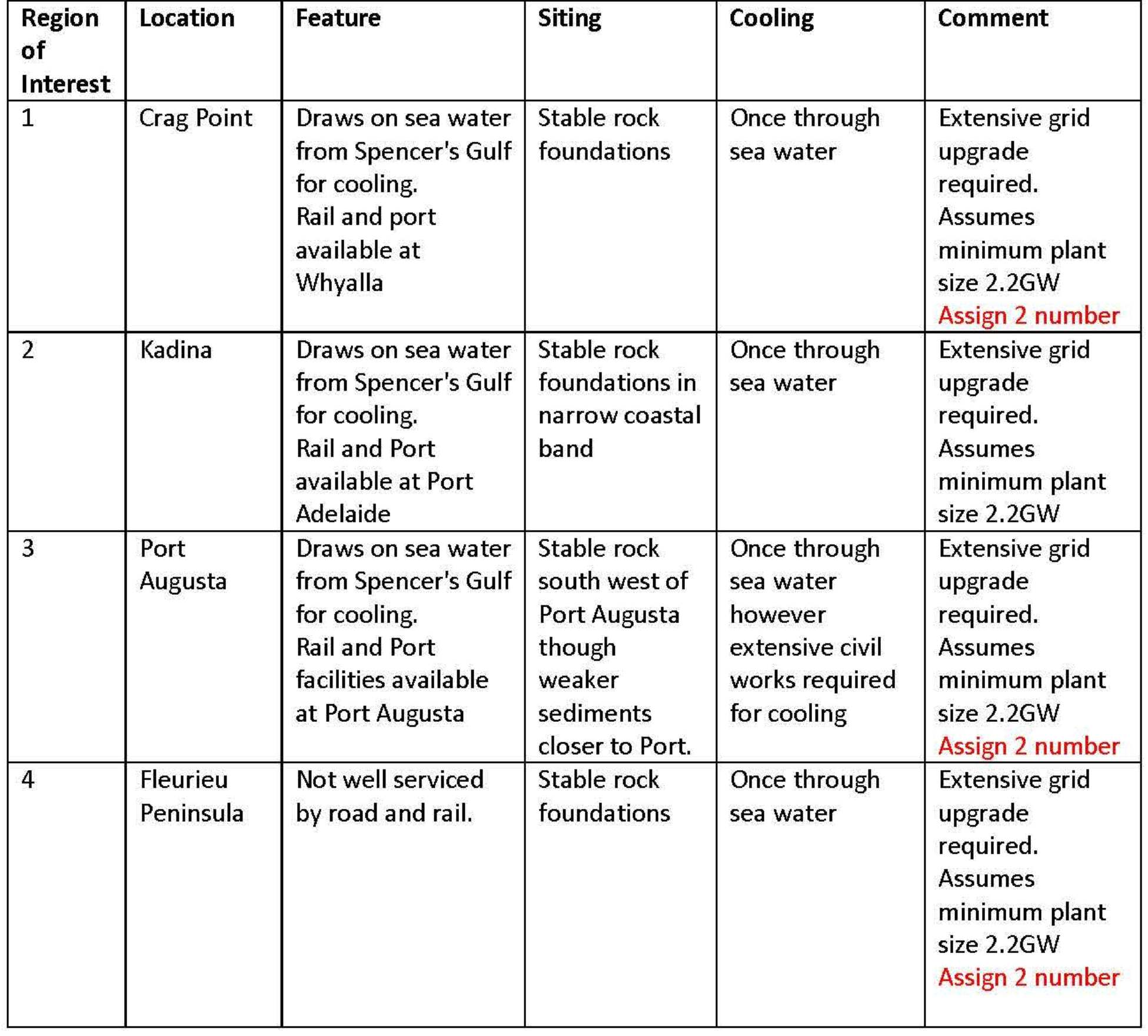
South Australian Regions of Interest
Edition 3, Revised 19/10/2016
Regions of Interest for Nuclear Power Plants in South Australia
This plan envisages 4 Reactors being constructed in South Australia by 2040 providing 4.47GW of capacity operating at a capacity factor of 0.92 to provide 31.3 TWh of annual power. The image shows selected regions of interest placed on the existing grid.
The South Australian electricity sent out generation in 2050 is assumed to be 28 TWh per annum from the BREE energy projections. Allowing for 80% of this to come from nuclear energy will require the equivalent of 2.9 x AP1000 reactors operating at a capacity factor of 80%. Additionally, assuming 80% of the light vehicle fleet and 40% of the heavy vehicle fleet runs on electricity or fuels derived from electricity, then an additional 0.64 reactors would be required. A further requirement for the replacement of fossil fuels in industry would see a further reactor equivalence of 1.4 units.
This makes 4.94 x AP1000 reactors in total. For the purposes of this study this has been rationalised to four units with the deficit being provided by other generators in other states.
Peak demand projections vary between the AEMO and BREE reports. For the purposes of this study 3,424 MW in 2011 may increase by 33% in 2050 to 4,550 MW which is in close accord with the 4.47GW capacity of these four reactors.
Four regions of interest have been identified in South Australia on the basis of geology and proximity to the coast for once through sea water cooling. No inland water resources are available in South Australia for reactor cooling.
Seismicity at South Australian sites
Three possible areas suitable for nuclear power plants are identified.
The sites are:
- Site 1 – Crag Point, West side of Spencers Gulf
- Site 2 – Kadina site, Spencer’s Gulf east coast
- Site 3 – Port Augusta region. Sites to south west in Upper Spencer’s Gulf
- Site 4 – Fleurieu Peninsula
Nuclear facilities are rigorously designed to cope with the effects of earthquakes such that the plants are able to operate continuously during and after the Design Basis Earthquake (DBE). The profession is highly experienced in the area of seismic design and seismic response. Even during the catastrophic earthquake in Japan in 2011, the nuclear plants performed as intended—the associated tsunami was the cause of the widespread damage, not the earthquake per se.[i]
As stated on the World Nuclear Association website, the Peak Ground Acceleration (PGA) or Design Basis Earthquake Ground Motion (DBGM) is used as a measure of the size of an earthquake. It is measured in Galileo units – Gal (cm/sec2) or g – the force of gravity, 1.0 g being 980 Gal. The PGA is one measure but of course the seismic design basis for a nuclear power plant includes other parameters such as the frequency content and duration of the design earthquake, damping (energy dissipation) in the foundation media, surrounding soil or rock and the structure itself. Modern nuclear plants are designed for a standardized earthquake, and therefore, the site where the nuclear plant is constructed must have a seismic hazard level enveloped by the standardized design.
For example, the Westinghouse AP1000 Nuclear Plant standardized design PGA is 0.3g. This PGA is significantly higher than the seismic hazard level expected for sites in South Australia.

Figure 2 – The hazard map of South Australia with an annual probability of exceedence of 1/500 at a SA period of 0.0s (PGA).

Figure 3 – The hazard map of South Australia with an annual probability of exceedence of 1/2500 at a SA period of 0.0s (PGA).
For the four site localities chosen reference is now made to the Atlas of Seismic Hazard Maps of Australia as published by Geoscience Australia[ii]. Relevant figures are shown in Figure 2 and Figure 3 which map the annual exceedence probability of peak ground acceleration for earthquakes covering these sites.
[i] http://www.world-nuclear.org/info/Safety-and-Security/Safety-of-Plants/Nuclear-Power Plants-and-Earthquakes/
[ii] Atlas of Seismic Hazard Maps of Australia Seismic hazard maps, hazard curves and hazard spectra. GEOSCIENCE AUSTRALIA RECORD 2013/41
Reactor seismic capacity versus South Australian probability
Typical power reactors that could be deployed in the near term are now listed and for two of them we have design basis earthquake (DBE) capacities.
- The AP1000 NPP safe shutdown earthquake design is for a peak ground acceleration of 0.3g. This design exceeds the largest recorded earthquake in the UK.[iii]
- For EC6, the Design Basis Earthquake (DBE) has been increased to from 0.2g to 0.3g peak ground acceleration in the generic design.[iv]
- For the VVER 1000 there is some indication INPRO Forum, IAEA, Vienna, 19-22 November, 2013 that the DBE is 0.25g [v]
The Design Basis Earthquake (DBE) is the earthquake which the structure is required to safely withstand with repairable damage. Those systems and components important to safety must remain functional and/or operable. For design purposes, the intended use of this earthquake loading is for economic design of structures or components whose damage or failure would not lead to catastrophic loss.
We apply the values from Figure 2 and Figure 3 to the three site areas selected. It should be noted that the occurrence of earthquake with a PGA lower than 0.3g will not impact the performance of functionality of the AP1000 or other reactors with the same seismic capacity. For an earthquake having a PGA equal to or greater than 0.3g, the nuclear power plant will automatically shut down with only superficial damage
In Table 1 we note that for the 1:500 and 1:2,500 yearly probability event all values are less than half of the DBE capacity of 0.3g. Using the PGA associated with a 2,500 year event, and doubling the value of the PGA to obtain an estimate of the 10,000 year event, the site-specific DBE has a PGA lower than the standardized AP1000 value of 0.3g.
It should be noted that the occurrence of earthquake with a PGA lower than 0.3g will not impact the performance of functionality of the AP1000. For an earthquake having a PGA equal to or greater than 0.3g, the nuclear power plant will automatically shut down with only superficial damage.
Table 1 – Peak Ground Acceleration values for then four sites
| Site No. | Site | 1 in 500 year | 1 in 2,500 years | 1 in 10,000 years Assumed equal to PGA2500 event x 2 |
| 1 | Upper Spencer Gulf Crag Point | 0.05 | 0.14 | 0.28 |
| 2 | Kadina site, Spencer’s Gulf east coast | 0.04 | 0.12 | 0.24 |
| 3 | Port Augusta region. Sites to south west in Upper Spencer’s Gulf | 0.05 | 0.13 | 0.26 |
| 4 | Fleurieu Peninsula | 0.045 | 0.13 | 0.26 |
[iii] UK AP1000 Environment Report, UKP-GW-GL-790, Revision 4 Westinghouse Electric Company LLC
[iv] Consideration of Candu and other Medium Size PWR reactors (600 to 700 MWe Class, Low Emissions Strategies and Clean Energy Development in E&E, by Tetra Tech ES for United States Agency for International Development, Dec 2014
[v] AES-2006 – new design with VVER reactor and INPRO methodology, INPRO Forum, IAEA, Vienna, 19-22 November, 2013
Cooling Nuclear Power Stations in South Australia
The four regions of interest in South Australia would all use once through sea water cooling. Within the region south west of Port Augusta a potential site exists at Lat -32.561968 deg, Long 137.737543. This location is approximately 2km from a sea water inlet at Spencers Gulf and would require significant civil works to construct a sea water inlet/outlet for cooling. This location is directly on the route of the transmissions lines leading from switchyards at the closed Playford and Northern coal power stations.
The tabulation shows the anticipated type of cooling at each plant
An excellent and detailed outline of the cooling options is available at: Cooling Power Plants | Power Plant Water Use for Cooling – World Nuclear Association


